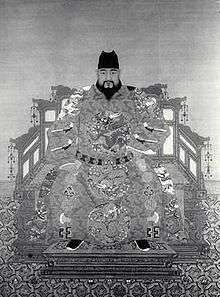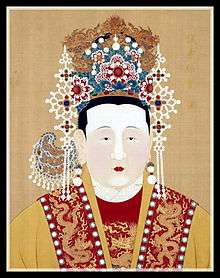Emperor Yingzong of Ming
| Emperor Yingzong of Ming 明英宗 | |||||||||||||||||
|---|---|---|---|---|---|---|---|---|---|---|---|---|---|---|---|---|---|
 | |||||||||||||||||
| 6th Emperor of the Ming dynasty | |||||||||||||||||
| Reign | 7 February 1435 – 1 September 1449 | ||||||||||||||||
| Coronation | 7 February 1435 | ||||||||||||||||
| Predecessor | Xuande Emperor | ||||||||||||||||
| Successor | Jingtai Emperor | ||||||||||||||||
| Retired Emperor of the Ming dynasty | |||||||||||||||||
| Reign | 1 September 1449 – 11 February 1457 | ||||||||||||||||
| 8th Emperor of the Ming dynasty | |||||||||||||||||
| Reign | 11 February 1457 – 23 February 1464 | ||||||||||||||||
| Predecessor | Jingtai Emperor | ||||||||||||||||
| Successor | Chenghua Emperor | ||||||||||||||||
| Born | 29 November 1427 | ||||||||||||||||
| Died | 23 February 1464 (aged 36) | ||||||||||||||||
| Burial | Yuling, Ming tombs, Beijing | ||||||||||||||||
| |||||||||||||||||
| House | House of Zhu | ||||||||||||||||
| Father | Xuande Emperor | ||||||||||||||||
| Mother | Empress Xiaogongzhang | ||||||||||||||||
Zhu Qizhen (Chinese: 朱祁鎮; 29 November 1427 – 23 February 1464) was the sixth and eighth emperor of the Ming dynasty. He ascended the throne as the Zhengtong Emperor (Chinese: 正統; pinyin: Zhèngtǒng; literally: "right governance") in 1435, but was forced to abdicate in 1449, in favour of his younger brother the Jingtai Emperor, after being captured by the Mongols during the Tumu Crisis. In 1457, he deposed Jingtai and ruled again as the Tianshun Emperor (Chinese: 天順; pinyin: Tiānshùn; literally: "obedience to Heaven") until his death in 1464.[2] His temple name is Yingzong (英宗).
First reign

Zhu Qizhen was the son of the Xuande Emperor and his second wife, Empress Sun. At the beginning of the Zhengtong reign, the Ming dynasty was prosperous and at the height of its power as a result of the Xuande Emperor's able administration. The Zhengtong Emperor's accession at the age of eight made him the first child emperor of the dynasty – hence the Zhengtong Emperor was easily influenced by others, especially the eunuch Wang Zhen. At first, Wang Chen was kept under control by Grand Mother Empress Zhang, Zhengtong's grandmother and the unofficial regent, who collaborated closely with three ministers, all with the surname Yang (hence the common name "Three Yangs"), thus the good administration continued. In 1442 though, Empress Zhang died, and the three Yangs also died or retired around that time.[3]

The emperor began to completely rely on Wang Zhen for advice and guidance.
Imprisonment by the Mongols
At the age of 21, in 1449, the Zhengtong Emperor, advised by Wang Zhen, personally directed and lost the Battle of Tumu Fortress against the Mongols under Esen Taishi (d.1455). In one of the most humiliating battles in Chinese history, the Ming army, half million strong, led by Zhengtong, was crushed by Esen's forces, estimated to be 20,000 cavalry.[4][5] His capture by the enemy force shook the empire to its core, and the ensuing crisis almost caused the dynasty to collapse had it not been for the capable governing of a prominent minister named Yu Qian.
Although the Zhengtong Emperor was a prisoner of the Mongols, he became a good friend to both Tayisung Khan Toghtoa Bukha (1416–1453) and his grand preceptor (taishi) Esen. Meanwhile, to calm the crisis at home, his younger brother Zhu Qiyu was installed as the Jingtai Emperor. This reduced the Zhengtong Emperor's imperial status and he was granted the title of Tàishàng Huángdi (emperor emeritus).
House arrest and second reign
The Zhengtong Emperor was released one year later in 1450, but when he returned to China, he was immediately put under house arrest by his brother for almost seven years. He resided in the southern palace of the Forbidden City, and all outside contacts were severely curtailed by the Jingtai Emperor. His son, who later became the Chenghua Emperor, was stripped of the title of crown prince and replaced by the Jingtai Emperor's own son. This act greatly upset and devastated the former Zhengtong Emperor, but the heir apparent died shortly thereafter. Overcome with grief, the Jingtai Emperor fell ill, and the former Zhengtong Emperor decided to depose his brother by a palace coup. The emperor emeritus was successful in seizing the throne from the Jingtai Emperor when the latter was ill, after which he changed his regnal name to "Tianshun" (lit. "obedience to Heaven") and went on to rule for another seven years. Jingtai Emperor was demoted to Prince of Cheng and put under house arrest and soon died, probably murdered.
On 6 August 1461, the Tianshun Emperor issued an edict warning his subjects to be loyal to the throne and not to violate the laws.[6] This was a veiled threat aimed at the general Cao Qin (d. 1461), who had become embroiled in a controversy when he had one of his retainers kill a man whom Ming authorities were attempting to interrogate (to find out about Cao's illegal foreign business transactions).[6] On 7 August 1461, Cao Qin and his cohorts of Mongol descent attempted a coup against the Tianshun Emperor.[7] However, during the first hours of the morning of 7 August, prominent Ming generals Wu Jin and Wu Cong, who were alerted of the coup, immediately relayed a warning to the emperor.[8] Although alarmed, the Tianshun Emperor and his court made preparations for a conflict and barred the gates of the palace.[9] During the ensuing onslaught in the capital later that morning, the Minister of Works and the Commander of the Imperial Guard were killed, while the rebels set the gates of the Forbidden City on fire.[7] The eastern and western gates of the imperial city were only saved when pouring rains came and extinguished the fires.[10] The fight lasted for nearly the entire day within the city; during which three of Cao Qin's brothers were killed, and Cao himself received wounds to both arms. With the failure of the coup, in order to escape being executed, Cao fled to his residence and committed suicide by jumping down a well within the walled compound of his home.[11]
The Tianshun Emperor died at the age of 36 in 1464 and was buried in the Yuling (裕陵) mausoleum of the Ming Dynasty Tombs. Before he died, he had given an order, which was rated highly as an act of imperial magnanimity, that ended the practice of burying alive concubines and palace maids (so that they could follow emperors to the next world).[12]
Popular culture
- Portrayed by Kwon Bin in the 2016 KBS1 TV series Jang Yeong-sil.
- In the computer game Europa Universalis IV he is the emperor of the playable Ming dynasty at the games start date of 1444.
Family
- Parents:
- Zhu Zhanji (宣宗 朱瞻基; 1399 – 1435)
- Empress Sun (孝恭章皇后 孫氏; 1399 – 1462)
- Consorts and Issue:
- Empress Qian (孝莊睿皇后 錢錦鸞; 1426 – 1468), personal name Jinluan
- Empress dowager Zhou (孝肅皇后 周氏; 1430 – 1504)
- Princess Chongqing (重慶公主; 1446 – 1499)
- Zhu Jianshen (憲宗 朱見深; 1447 – 1487)
- Zhu Jianze (崇簡王 朱見澤; 1455 – 1505)
- Fourth rank consort Wan (靖莊宸妃 萬氏; 1431 – 1467)
- Zhu Jianlin (德莊王 朱見潾; 1448 – 1517)
- Zhu Jianshi (朱見湜; 1449 – 1451)
- Princess Chun'an (淳安公主)
- Princess Guangde (廣德公主 朱延祥; 1454 – 1484), personal name Yanxiang
- Zhu Jianjun (吉簡王 朱見浚; 1456 – 1527)
- Zhu Jianzhi (忻穆王 朱見治; 1458 – 1472)
- Fourth rank consort Wang (端靖惠妃 王氏; 1429 – 1485)
- Princess Jiashan (嘉善公主; c. 1448 – 1499)
- Zhu Jianchun (許悼王 朱見淳; 1450 – 1453)
- Fourth rank consort Yang (莊僖安妃 楊氏; 1414 – 1487)
- Princess Chongde (崇德公主; c. 1451 – 1489)
- Fourth rank consort Gao (莊靜淑妃 高氏; 1429 – 1511)
- Zhu Jianshu (秀懷王 朱見澍; 1452 – 1472)
- Princess Longqing (隆慶公主; 1455 – 1480)
- Fourth rank consort Wei (恭端德妃 魏氏; 1426 – 1469)
- Princess Yixing (宜興公主; c. 1454 – 1514)
- Unnamed daughter
- Zhu Jianpei (徽莊王 朱見沛; 1462 – 1505)
- Fourth rank consort Fan (恭和順妃 樊氏; 1414 – 1470)
- Unnamed daughter
- Fourth rank consort Liu (安和麗妃 劉氏; 1426 – 1512)
- Fourth rank consort Wang (昭肅賢妃 王氏; 1430 – 1474)
- Fourth rank consort Wu (端莊昭妃 武氏; 1431 – 1467)
- Fourth rank consort Gong (恭安和妃 宮氏; 1430 – 1467)
- Fourth rank consort Wang (榮靖貞妃 王氏; 1427 – 1507)
- Fourth rank consort Zhao (恭靖莊妃 趙氏; 1446 – 1514)
- Fourth rank consort Liu (貞順敬妃 劉氏; d. 1463)
- Fourth rank consort Liu (昭靜恭妃 劉氏; d. 1500)
- Fourth rank consort Li (昭懿賢妃 李氏)
- Fourth rank consort Zhang (恭僖成妃 張氏; d. 1504)
- Fourth rank consort Yu (僖恪充妃 余氏; d. 1503)
- Fourth rank consort Chen (惠和麗妃 陳氏; d. 1500)
- Fourth rank consort Liu (妃 劉氏)
- Princess Jiaxiang (嘉祥公主; c. 1459 – 1483)
- Unknown
- Unnamed daughter
- Unnamed daughter
See also
References
- ↑ Tianshun (天順) was also the name of a reign era in the Yuan dynasty.
- ↑ Leo K. Shin (2006), The Making of the Chinese State: Ethnicity and Expansion on the Ming Borderlands, Cambridge University Press, ISBN 978-0-521-85354-5
- ↑ 刘, 金泽 (1998). 政鉴. 经济日报出版社. p. 828. ISBN 9787801275103.
- ↑ Haskew, Michael E. (2008). Fighting Techniques of the Oriental World AD 1200-1860: Equipment, Combat Skills And Tactics, Christer Jørgensen. Amber Books. p. 12. ISBN 9781905704965.
- ↑ Wen chao yue kan, Volume 5. 北京 :: 全国图书馆文献缩微复制中心. 2005. p. 128.
- 1 2 Robinson, 97.
- 1 2 Robinson, 79.
- ↑ Robinson, 101–102.
- ↑ Robinson, 102.
- ↑ Robinson, 105.
- ↑ Robinson, 107–108.
- ↑ Zhonghua quan guo fu nü lian he hui (1984). Women of China. Foreign Language Press.
- Robinson, David M. "Politics, Force and Ethnicity in Ming China: Mongols and the Abortive Coup of 1461," Harvard Journal of Asiatic Studies (Volume 59: Number 1, June 1999): 79–123.
Emperor Yingzong of Ming Born: 29 November 1427 Died: 23 February 1464 | ||
| Regnal titles | ||
|---|---|---|
| Preceded by Xuande Emperor |
Emperor of China (Zhengtong reign) 1435–1449 |
Succeeded by Jingtai Emperor |
| Preceded by Jingtai Emperor |
Emperor of China (Tianshun reign) 1457–1464 |
Succeeded by Chenghua Emperor |